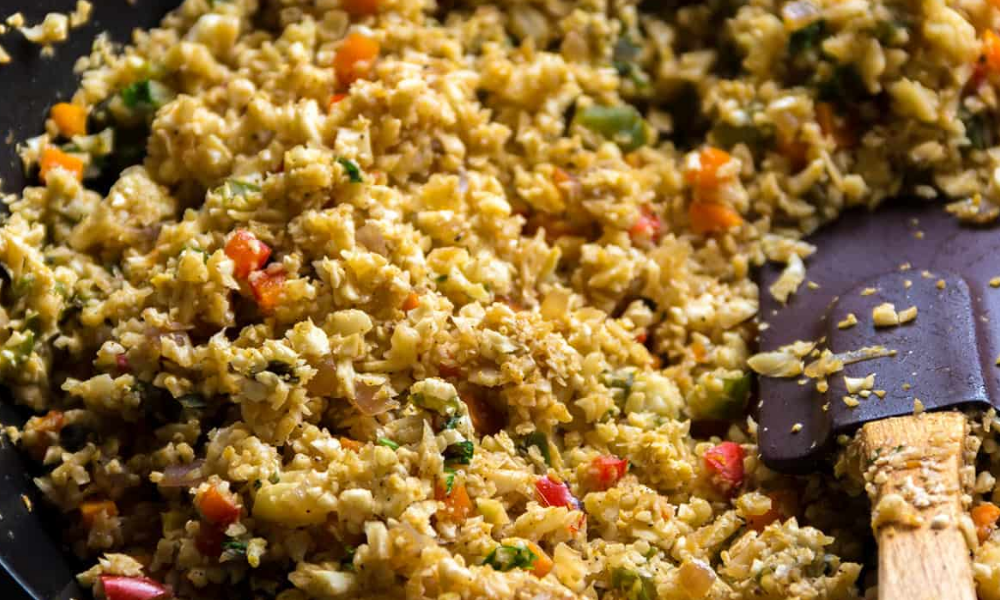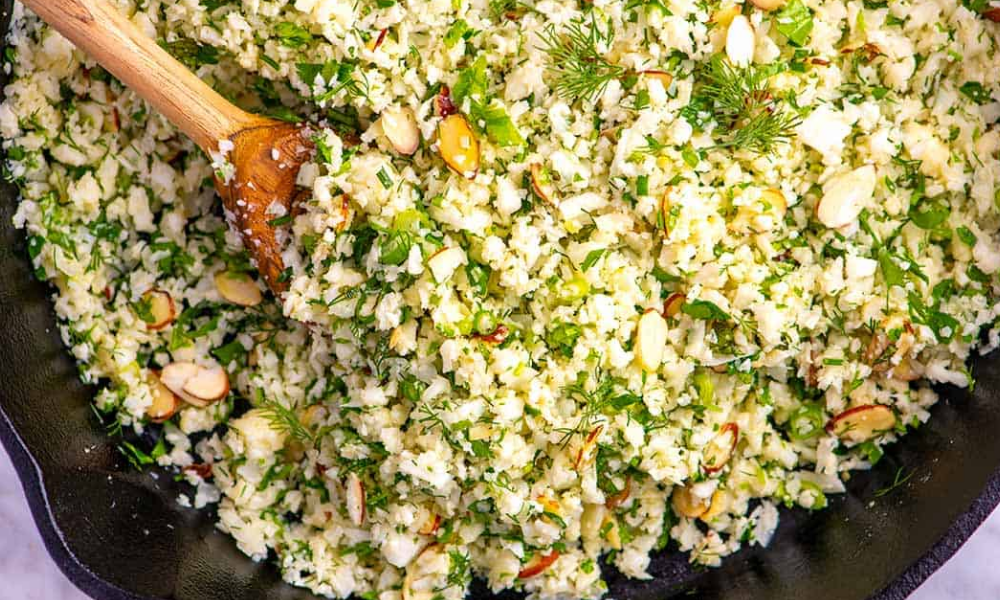Cauliflower has become one of my favourite vegetables to use in the kitchen. Preparing this cruciferous vegetable as rice is one of my absolute favourite things to do with it. Because rice may often lead recipes to have a heaviness to them, it is pleasant to utilize a vegetable in places where starch would typically be used. In addition to this, it is a fantastic method for including additional portions of veggies into your daily diet.
First used the term “couscous” to refer to cauliflower in 1998 in California by a chef called Ben Ford. It seems to be the same product, although having a new name, as far as we can determine. Around 2012, “cauliflower rice” became popular on the internet. However, ever since that time, demand for this alternative to rice that is rich in nutrients has skyrocketed.
What is Cauliflower Rice?
Cauliflower rice is an alternative to traditional white rice produced completely from cauliflower and does not include any grains, and has reduced carbohydrate content. A large head of cauliflower may be converted into grain-sized pieces, giving the appearance of rice, with very little effort using a food processor.
Cauliflower’s rigid structure makes it simple to cut the vegetable into small pieces and ensures that the resulting pieces maintain their grain-like form even after being cooked.
What does Cauliflower Rice Taste Like?
When cooked, the cauliflower loses any somewhat harsh and cabbage-like odours that it may have had. This makes room for the cauliflower’s delicate nutty tastes to come through. The fact that it has hidden undertones makes it adaptable, and it is simple to alter the flavour by using a variety of spices.
Nutrition
- Serving: 1 half-cup serving
- Calories: 25
- Carbohydrates: 5.3 g
- Protein: 2 g
- Fat: 0.1 g
- Saturated Fat: 0 g
- Trans Fat: 0 g
- Cholesterol: 0 mg
- Sodium: 30 mg
- Fibre: 2.5 g
- Sugar: 2.4 g
How to Make Cauliflower Rice?
Ingredients
- 16 ounces of pre-made cauliflower rice or one medium-to-large head of cauliflower, plus two teaspoons of extra virgin olive oil
- Two chopped or pressed garlic cloves 1/4 teaspoon fine sea salt
- Optional: 2 tablespoons chopped cilantro or flat-leaf parsley
- Optional: fresh lemon or lime juice squeezed
- black pepper, freshly ground, to taste
Method
- There are two different ways that. May prepare cauliflower rice. To break it up into smaller pieces, you may use a box grater with holes of medium sizes, like the one depicted below, which is often reserved for grating cheese, or you can use a food processor fitted with a grater blade. Whether you use either method, you want to end up with bits around the size of rice grains.
- One more step I like to do is press any extra moisture out of the rice. To do this, I transfer the cauliflower rice to a big paper towel or an absorbent dish towel and squeeze or press it to remove any leftover water. This is an additional step, and this ensures that there is no extra moisture that is left, which might cause your food to get soggy.
- Rice is made from cauliflower, a grater, and pieces of cauliflower that have been cut and are ready to be grated.
- When you already have your cauliflower rice, preparing it is a breeze. Sauté the ingredients in a large pan with one tablespoon of oil over medium heat. Cover the cauliflower with a lid so that it may steam and become softer in the process. Cook for five to eight minutes, tossing the mixture frequently, and then season it as you see fit (such as soy sauce or salt and pepper).
Instructions
- Cauliflower should be washed, dried completely, and should remove its greens.
- If you plan on using a box grater, chop the cauliflower into big pieces and grate it using medium-sized holes. If you use a food processor, chop the cauliflower into tiny pieces, switch to the grater attachment, and grind the cauliflower until it resembles rice.
- Transfer the dish to a clean towel or paper towel and press it to remove any extra moisture, which, if left, may cause the dish to get soggy. This step is optional.
- Replace regular rice in dishes like stir-fries and fried rice with rice made from cauliflower instead! You may keep any leftovers for up to 5 days in the refrigerator. Cauliflower rice that has not been cooked may be kept in the freezer for up to one month.
Ways to Use Cauliflower Rice
May prepare cauliflower rice in various ways, the most straightforward of which is to sauté it in butter or olive oil and season it with salt and pepper. Because it just takes around five minutes to cook, it is an easy-to-prepare option that may be used as a side dish.
Using cauliflower rice as a substitute for regular rice in risotto, grits, and fried rice. It is also possible to consume it raw, so try adding it to salads for an added crunch or use it in place of farro or quinoa in grain salads the same way you would use those grains.
Benefits of Cauliflower for Health
- For a variety of reasons, cauliflower is one of my FAVORITE veggies. First, cauliflower is a readily available, affordable vegetable that lasts a long time. It is INCREDIBLY adaptable, and its mild taste complements a wide variety of cuisines while balancing the flavours of stronger recipes. You’ll want to learn to make cauliflower rice since it is so nutritious! The following are some health advantages of using cauliflower in your diet:
- It is nutrient-dense: Cauliflower includes a wealth of nutrients, including vitamins C, K, and B6, folate, potassium, manganese, magnesium, and phosphorus, all of which are crucial for the body’s proper operation.
- It has a lot of fibre: Fiber feeds the beneficial bacteria in your stomach that supports digestive health and lowers inflammation, so getting enough of it is crucial for your general health and wellness.
- It is a fantastic source of antioxidants, crucial for good health since they protect your cells, increase immunity, and may help prevent illness.
How Long does Cauliflower Rice Last?
Raw Cauliflower Rice
When we make cauliflower into cauliflower rice and then store it in the refrigerator for a few days, we notice that it acquires a strong sulphur smell that is both unpleasant and unappealing. Therefore, you should either utilize it straight now or freeze it for later use.
Cooked Cauliflower Rice
Cauliflower rice that has been cooked won’t take on an unpleasant odour nearly as rapidly as raw cauliflower rice. Cauliflower rice that has been cooked may be stored in an airtight container in the refrigerator for about four days.
Can you Freeze Riced Cauliflower?
Yes! After squeezing out the excess moisture and before boiling the riced cauliflower, we suggest storing it for later use. Freeze for up to one month in an airtight container (we prefer to use Stasher bags for this).
Is Cauli Rice Healthy?
The nutritional powerhouse of cauliflower rice is loaded with antioxidants such as vitamins A and C. These antioxidants rid your body of the potentially harmful effects of free radicals. Free radicals are oxygen molecules that are not bound to any particular atom and have been linked to cancer. Antioxidants are known to help reduce the risk of cancer because they neutralize cancer-causing free radicals.
Is Cauliflower Rice Better than Brown Rice?
In comparison, a serving of riced cauliflower has just 5 grams of carbohydrates, whereas a dish of brown rice contains 45 grams. What is this, exactly? In addition to its high fibre content, cauliflower is a good source of antioxidants, folate, vitamin K, and protein.
Can you Gain Weight by Eating too Much Cauliflower?
Iodine Absorption and Cauliflower Hypothyroidism, characterized by a slowed metabolism, increased sensitivity to cold, dry hair and skin, difficulty thinking, and weight gain, may occur if you consume a diet almost entirely composed of cruciferous vegetables. This type of diet can also cause iodine absorption problems.
Does Cauliflower Make you Gassy?
It is well known that eating certain vegetables, such as Brussels sprouts, cabbage, broccoli, asparagus, and cauliflower, may increase gas. Raffinose is another kind of complex sugar and may find it in these veggies and can find it in beans. However, given that these foods are considered the healthiest available, you may want to consult with your physician before cutting them out of your diet.
Which is Healthier, Cauliflower or Broccoli?
Compared to cauliflower, broccoli provides a higher total number of calories and more protein, lipids, and carbohydrates. On the other side, cauliflower has a higher concentration of sugars, but broccoli has a higher concentration of nutritional fibre. More vitamins and minerals, such as vitamin E, vitamin K, vitamin A, and vitamin C, as well as calcium, iron, zinc, and phosphorus, may be found in broccoli.
Why is Cauliflower not Good for you?
Like many other cruciferous vegetables (such as broccoli and Brussels sprouts), Cauliflower contains the complex sugar raffinose. Because the human body has difficulty breaking down this sugar, it makes its way through the digestive tract undigested and fermented by bacteria in the large intestine, which may cause bloating and gas.
Is Cauliflower Good for High Blood Pressure?
It has been shown that the phytonutrient indole-3-carbinol, which may be found in cauliflower and other cruciferous vegetables, can assist the liver in its detoxification processes. 3. It helps lower blood pressure that has been elevated. Consuming cauliflower may assist in increasing levels of HDL cholesterol, which is the “good” sort of cholesterol and lowering blood pressure.
Is Cauliflower Rice Starchy?
Using cauliflower in place of rice has seen a meteoric rise in popularity over the last several years, with good cause. Cauliflower rice is a nutritious vegetable that is free of gluten and has a low number of carbohydrates. As a result, it is an excellent replacement for starchy meals such as mashed potatoes, rice, and pizza crust.
Can Cauliflower be Eaten Every day?
Consuming a varied and well-balanced diet is almost always preferable to focusing on a particular kind of food. Although cauliflower is usually considered to be a healthy vegetable due to its high vitamin C and vitamin K content, as well as its low-calorie count and high fibre content, certain individuals should avoid eating cauliflower. . may obtain the health advantages of cauliflower by eating one cup of vegetables once every week without any adverse effects.
Conclusion
You may be curious about the flavour of freshly riced cauliflower when you learn how to prepare it in the kitchen. The flavour of cauliflower is comparable to that of rice since the vegetable has a flavour that is so subtle. Cauliflower that has been riced has a consistency comparable to that of rice, making it an excellent substitute and an option lower in carbohydrates that everyone will appreciate.


